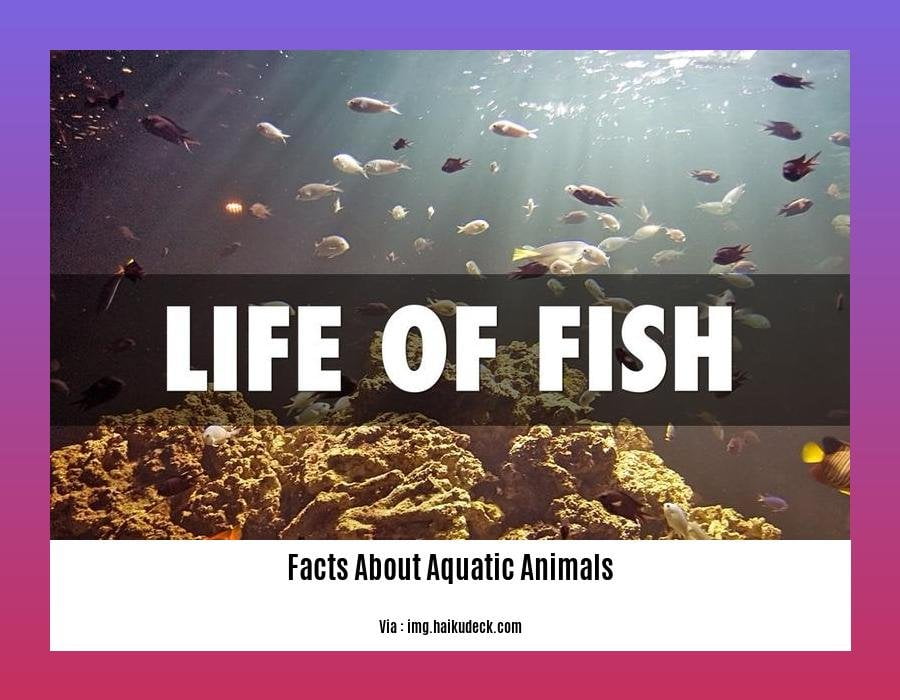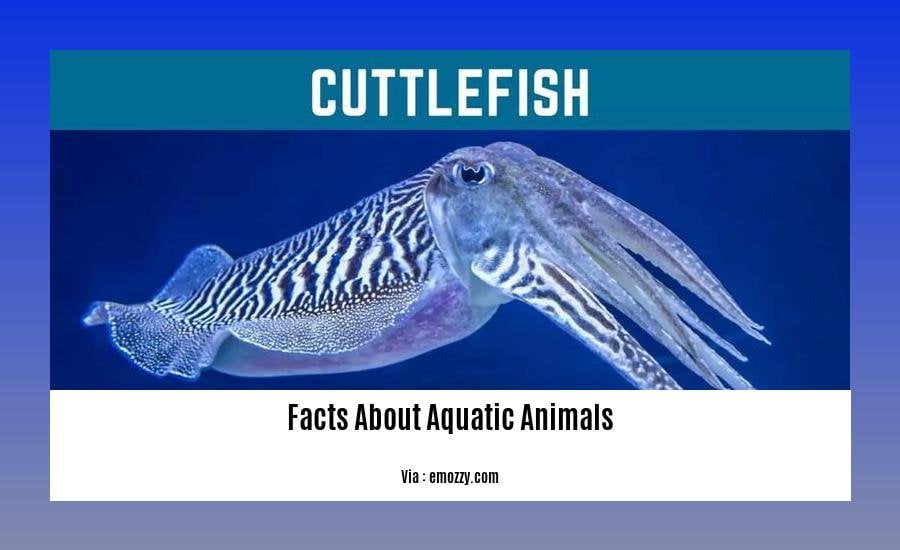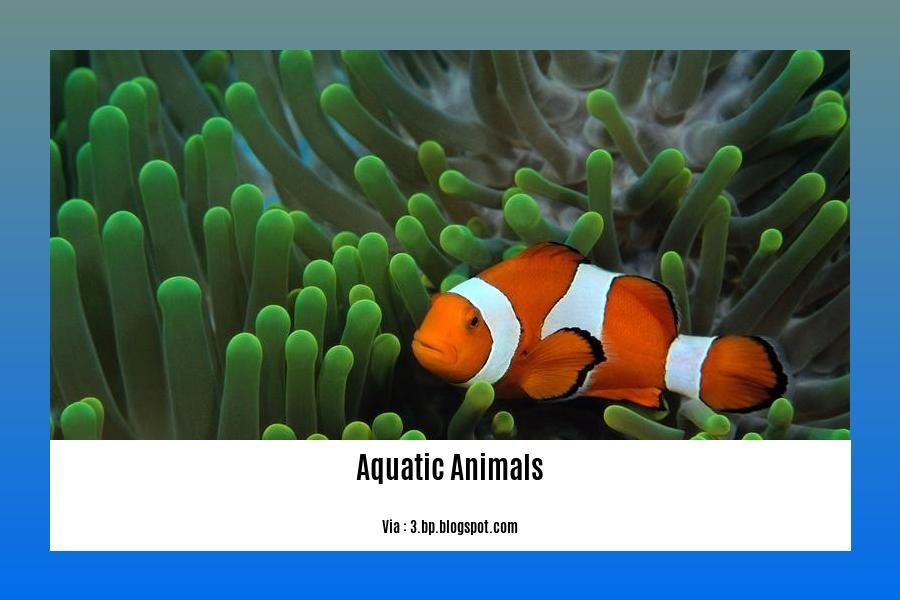If you’ve ever found yourself captivated by the wonders of the ocean and the fascinating creatures that call it home, get ready to dive into a world of incredible facts about aquatic animals. In this article, we’ll explore the captivating realm of marine life, uncovering lesser-known tidbits about underwater animals, sea creatures, and the wonders of the ocean. From dazzling adaptations to mesmerizing behaviors, prepare to be amazed by the sheer diversity and ingenuity of these remarkable creatures. Join us as we embark on a journey through fascinating facts about aquatic animals, and discover the hidden wonders lying beneath the ocean’s surface.
Key Takeaways:
1. Seahorses are unique because the males give birth and care for their young.
2. The heart of a shrimp is located in its head.
3. Sea sponges are alive even though they have no head, mouth, eyes, feelers, bones, heart, lungs, or brain.
4. Turtles can be found on every continent except Antarctica.
5. Starfish can have up to 16 arms.
6. Jellyfish are made up of 95% water.
7. Octopuses have 3 hearts.
8. Sea horses move by pulling themselves with their chins.
9. Sharks are immune to all known diseases, making them very healthy.
10. Aquatic animals can be either vertebrate or invertebrate and can live in both saltwater and freshwater.
11. They have streamlined bodies and scaled, smooth skin.
12. Aquatic animals have fins that aid in swimming, and some have webbed limbs or paddles.
Facts About Aquatic Animals: Exploring the Wonders of Marine Life


Seahorses: Male Pregnancy and Parental Care
Did you know that seahorses are one of the few species where males give birth and take care of their young? It’s true! Male seahorses have a unique reproductive system where the female deposits her eggs into a special pouch on the male’s abdomen. Here, the male fertilizes and nurtures the eggs until they hatch, releasing fully-formed, tiny seahorses into the waters. This extraordinary phenomenon showcases the incredible diversity of parenting strategies found in aquatic animals.
Shrimps with Hearts in Their Heads
You might think that the heart belongs in the chest, but not for shrimps! These fascinating creatures have their hearts located in their heads. Yes, that’s right, their heads! This adaptation helps shrimps circulate oxygen-rich blood efficiently throughout their bodies, allowing them to thrive in their watery habitats. It’s just one of the many unique features that make aquatic animals so intriguing.
Sea Sponges: Silent and Alive
Sea sponges may not possess the typical characteristics we associate with living creatures, such as heads, mouths, or even brains, but they are alive! These remarkable organisms may appear to be simple structures, but don’t be fooled by their appearance. Sea sponges are living beings that play essential roles in marine ecosystems. They filter water, removing harmful substances, and provide habitats for a variety of marine organisms. Their ability to thrive without complex organs highlights the diverse forms of life hidden beneath the ocean’s surface.
Turtles: World Travelers
Turtles are marvelous creatures that can be found on every continent except for Antarctica. From sandy beaches to vast oceans and even freshwater habitats, turtles have successfully adapted to various environments across the globe. Whether they’re laying their eggs in tropical beaches or navigating the oceans with their streamlined bodies, turtles exemplify the incredible resilience and adaptability of aquatic animals.
Starfish with Multiple Arms
Starfish, also known as sea stars, are famous for their distinctive five arms. However, did you know that some species of starfish can have up to 16 arms? Imagine the grace and beauty of these creatures as they navigate the ocean currents using their flexible, elongated limbs. Starfish captivate with their stunning array of colors and intriguing movement, adding a touch of wonder to the underwater world.
Jellyfish: 95% Water Wonders
Jellyfish may seem ethereal and delicate, but they are 95% water! These mesmerizing creatures gracefully float through the oceans, showcasing their translucent bodies and trailing tentacles. Their composition is mostly water, giving them the ability to move effortlessly with the currents. Jellyfish possess a simplistic yet enchanting beauty, capturing the imagination of anyone fortunate enough to witness them.
Octopuses: The Admirable Trio of Hearts
Octopuses possess not one, not two, but three hearts! These intelligent and elusive creatures rely on their trio of hearts to pump blood throughout their bodies efficiently. While two hearts work tirelessly to send oxygen-rich blood to the octopus’s gills, the third heart powers circulation to the rest of its body. This unique adaptation contributes to their remarkable capabilities, allowing octopuses to thrive in the complex underwater world.
Sea Horses: Curious Chins
Have you ever wondered how sea horses move? Well, while most animals swim by undulating their bodies or using their fins, sea horses have a rather unusual method. They move by pulling themselves through the water using their chins! These captivating creatures gracefully glide through their habitats, propelled by their unique method of locomotion. It’s just one of the many peculiarities that make sea horses such beloved icons of marine life.
Sharks: Immunity Champions
When it comes to diseases, sharks are the true immune champions of the aquatic world. These formidable predators possess an incredible immune system that makes them immune to virtually all known diseases. From viral infections to bacterial illnesses, sharks remain in excellent health, ensuring their dominance in marine ecosystems. Their impressive resilience serves as a testament to the fascinating adaptations found within aquatic animals.
Diverse Aquatic Animals
Aquatic animals encompass a vast array of species, including both vertebrates and invertebrates. From the elegant dolphins and majestic whales to the tiny plankton that form the foundation of marine food chains, the diversity of aquatic life is awe-inspiring. These animals exhibit a range of adaptations, from streamlined bodies and smooth, scaled skin to fins, webbed limbs, and paddles that aid in swimming. Whether they inhabit saltwater or freshwater habitats, aquatic animals continue to captivate scientists and nature enthusiasts alike with their remarkable abilities and intricate existence.
In conclusion, the underwater world is a treasure trove of fascinating facts and astonishing creatures. From the remarkable parenting behaviors of seahorses to the unique adaptations of sharks, each aquatic animal holds its own special place in the intricate tapestry of marine life. Exploring these wonders not only satisfies our curiosity but also promotes a deeper appreciation for the remarkable biodiversity flourishing beneath the ocean’s surface. So, dive in, embrace the mysteries, and let the enchantment of aquatic animals inspire your love for the wonders of the seas.
Table: Aquatic Animals and their Unique Features
| Animal | Unique Feature |
|---|---|
| Seahorses | Males give birth and care for their young |
| Shrimps | Hearts located in their heads |
| Sea Sponges | Living creatures without heads, mouths, or brains |
| Turtles | Found on every continent except for Antarctica |
| Starfish | Can have up to 16 arms |
| Jellyfish | 95% water composition |
| Octopuses | Possess three hearts |
| Sea Horses | Move by pulling themselves with their chins |
| Sharks | Immune to all known diseases |
| Aquatic Animals | Vertebrate or invertebrate, live in saltwater or freshwater, possess streamlined bodies and fins or webbed limbs |
Now that we’ve explored these captivating facts, let’s marvel at the wonders of the aquatic world and continue to uncover the mysteries that lie beneath the waves. Happy exploring!
Did you know that there are fascinating facts about aquatic life that you probably haven’t heard before? Dive into the deep ocean and explore these intriguing creatures by clicking here. Discover the wonders that lie beneath the surface and uncover the secrets of our underwater world.
Are you curious to learn some extraordinary facts about cats and dogs? Click here to unveil intriguing information about these beloved pets. From their unique behaviors to their incredible abilities, you’ll be amazed by what you discover.
Calling all cat lovers! Get ready to be amazed by some mind-boggling facts about cats and kittens. Click here to explore the mysterious and fascinating world of our feline friends. Uncover their hidden talents and surprising behaviors that make them truly extraordinary.
Facts About Sea Animals
Sea animals are fascinating creatures with incredible adaptations and behaviors that never fail to amaze us. Let’s dive into the wonders of marine life and uncover some captivating facts about these incredible creatures.
1. Seahorses: Fathers of the Sea
Did you know that seahorses are unique among fish because it’s the males who give birth and care for their young? That’s right! Male seahorses have a special pouch where the females deposit their eggs. The males then fertilize and carry the eggs until they hatch, releasing fully formed miniature seahorses into the water. It’s a remarkable example of paternal care in the animal kingdom.
2. Shrimp: Hearts in Their Heads
You might be surprised to learn that shrimp have their hearts located in their heads. This unusual anatomical adaptation allows them to quickly circulate blood to their upper body and sensory organs. They rely on their hearts to pump blood and distribute oxygen throughout their tiny but complex anatomy. It’s a remarkable illustration of how marine life has evolved to thrive in diverse habitats.
3. Sea Sponges: Life Without Organs
Sea sponges are incredible organisms that defy the conventional concept of “organ” systems. Despite lacking heads, mouths, eyes, feelers, bones, hearts, lungs, or brains, they are indeed alive! They use specialized filtering cells called choanocytes to draw in water and filter out plankton and other nutrients. It’s a testament to the fascinating diversity and adaptability of life beneath the waves.
4. Turtles: Global Travelers
Turtles are quite the adventurers! They can be found on every continent except Antarctica. From the tropical beaches of the Caribbean to the cold waters of the Arctic, turtles have successfully carved out habitats in various environments. With their distinctive shells and ability to swim long distances, these ancient reptiles have conquered the oceans and captivated our imagination.
These are just a few captivating facts about sea animals that illustrate the incredible diversity and wonder of marine life. From the nurturing seahorse fathers to the unconventional anatomy of sea sponges, the ocean is brimming with fascinating stories waiting to be discovered.
Key Takeaways:
- Seahorses are unique among fish as males carry and give birth to their young. [^1^]
- Shrimp have their hearts located in their heads, ensuring efficient blood circulation. [^1^]
- Despite lacking organs and body parts like heads or hearts, sea sponges are alive and thriving. [^1^]
- Turtles can be found on every continent except Antarctica, showcasing their adaptability. [^1^]
Sources:
- All That’s Interesting – Ocean Animals Facts: 10 Amazing Things About Marine Life
Fascinating Facts About Ocean Animals
Exploring the Wonders of Marine Life
When it comes to ocean animals, there are a plethora of fascinating facts waiting to be discovered. From the tiniest organisms to the largest creatures in the sea, the diversity and wonders of marine life are truly captivating. Let’s dive deeper into the world of ocean animals and uncover some intriguing facts that highlight the incredible biodiversity thriving beneath the ocean’s surface.
Ocean Animals: A World of Wonders
1. A Vast Array of Marine Life: Ocean animals encompass not only various species of fish but also include a wide range of organisms such as mammals, reptiles, birds, invertebrates, and even plants. This rich diversity ensures that the ocean is teeming with life, each species playing a unique role in maintaining the delicate balance of marine ecosystems.
2. The Enigmatic Microscopic World: While we are familiar with many larger ocean animals, there is an entire universe of microscopic organisms that often go unnoticed. These tiny creatures, such as plankton and bacteria, form the foundation of the ocean’s food chain and play a crucial role in maintaining the health of marine ecosystems.
3. Surpassing Discoveries: The number of known marine species is staggering, with approximately 230,000 known species documented to date. However, scientists believe that there may be many more yet to be discovered, hiding in the depths of the ocean. The vastness of the ocean is a constant reminder of how much we have yet to explore and understand.
Fascinating Facts About Ocean Animals
1. The Timeless Jellyfish: Jellyfish, astonishingly, have been inhabiting the oceans for over 650 million years, predating both dinosaurs and sharks. Their unique and ancient existence is a testament to their remarkable adaptability and survival skills.
2. Electrifying Eels: Electric eels possess an extraordinary ability to generate electricity. They can produce enough electrical power to light up to 10 electric bulbs. This remarkable adaptation allows them to navigate their surroundings, communicate, and even stun their prey.
3. The Unconventional Sleep of Dolphins: Dolphins have an intriguing way of sleeping. They sleep with only half of their brain at a time and keep one eye open. This state of unihemispheric sleep enables dolphins to remain alert and vigilant in the face of potential predators or threats while still obtaining rest.
Key Takeaways:
- Ocean animals encompass a diverse array of organisms, including fish, marine mammals, reptiles, birds, invertebrates, and plants.
- The microscopic world of ocean animals, such as plankton and bacteria, plays a crucial role in marine ecosystems.
- There are approximately 230,000 known marine species, with the potential for many more yet to be discovered.
- Jellyfish have been inhabiting the oceans for over 650 million years, predating dinosaurs and sharks.
- Electric eels can produce enough electricity to light up to 10 electric bulbs.
- Dolphins sleep with only half of their brain and one eye open to remain vigilant.
Citations:
– “Ocean Animal Facts for Kids,” factsjustforkids.com
– “23 Ocean Animal Facts for Kids,” allthatsinteresting.com
FAQ
Q1: What makes seahorses unique among aquatic animals?
A1: Seahorses are unique among aquatic animals because the males are the ones who give birth and care for their young.
Q2: Where is the heart of a shrimp located?
A2: The heart of a shrimp is located in its head, which is an interesting feature among aquatic animals.
Q3: How do sea sponges survive without essential organs and body parts?
A3: Sea sponges are alive despite lacking many organs and body parts such as a head, mouth, eyes, feelers, bones, heart, lungs, or brain, which makes them fascinating organisms in the underwater world.
Q4: Where can turtles be found in terms of continents?
A4: Turtles can be found on every continent except Antarctica, highlighting their widespread presence and adaptability in aquatic ecosystems.
Q5: What are some amazing facts about jellyfish?
A5: Jellyfish are composed of 95% water, showcasing their unique characteristics among aquatic animals.
















